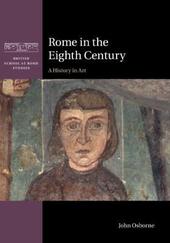
|
Rome in the Eighth Century: A History in Art
Hardback
Main Details
| Title |
Rome in the Eighth Century: A History in Art
|
| Authors and Contributors |
By (author) John Osborne
|
| Series | British School at Rome Studies |
|---|
| Physical Properties |
| Format:Hardback | | Pages:312 | | Dimensions(mm): Height 253,Width 182 |
|
| Category/Genre | Byzantine and medieval art c 500 CE to c 1400
History of architecture
Medieval European archaeology |
|---|
| ISBN/Barcode |
9781108834582
|
| Classifications | Dewey:945.63201 |
|---|
| Audience | | Professional & Vocational | |
|---|
| Illustrations |
Worked examples or Exercises; 10 Plates, color; 51 Halftones, black and white; 1 Line drawings, black and white
|
|
Publishing Details |
| Publisher |
Cambridge University Press
|
| Imprint |
Cambridge University Press
|
| Publication Date |
9 July 2020 |
| Publication Country |
United Kingdom
|
Description
This book addresses a critical era in the history of the city of Rome, the eighth century CE. This was the moment when the bishops of Rome assumed political and administrative responsibility for the city's infrastructure and the physical welfare of its inhabitants, in the process creating the papal state that still survives today. John Osborne approaches this using the primary lens of 'material culture' (buildings and their decorations, both surviving and known from documents and/or archaeology), while at the same time incorporating extensive information drawn from written sources. Whereas written texts are comparatively few in number, recent decades have witnessed an explosion in new archaeological discoveries and excavations, and these provide a much fuller picture of cultural life in the city. This methodological approach of using buildings and objects as historical documents is embodied in the phrase 'history in art'.
Author Biography
JOHN OSBORNE is a Distinguished Research Professor and Dean Emeritus in the Faculty of Arts and Social Sciences at Carleton University, Ottawa. He is a cultural historian of early medieval Italy with a focus on the material culture of Rome and Venice. His publications include studies of medieval use of the Roman catacombs, murals in churches such as San Clemente and Santa Maria Antiqua, cultural contacts between Rome and Constantinople, and the medieval understanding of Rome's heritage of ancient buildings and statuary.
Reviews'The new volume is an enterprising, wide-ranging synthesis unlike anything the author has attempted before ... It is a panoramic resume of Rome's cultural and institutional evolution over the course of the eighth century, that pivotal period when the city passed from imperial to papal control, presented through the lens of 'art.'' Hendrik Dey, Bryn Mawr Classical Review
|